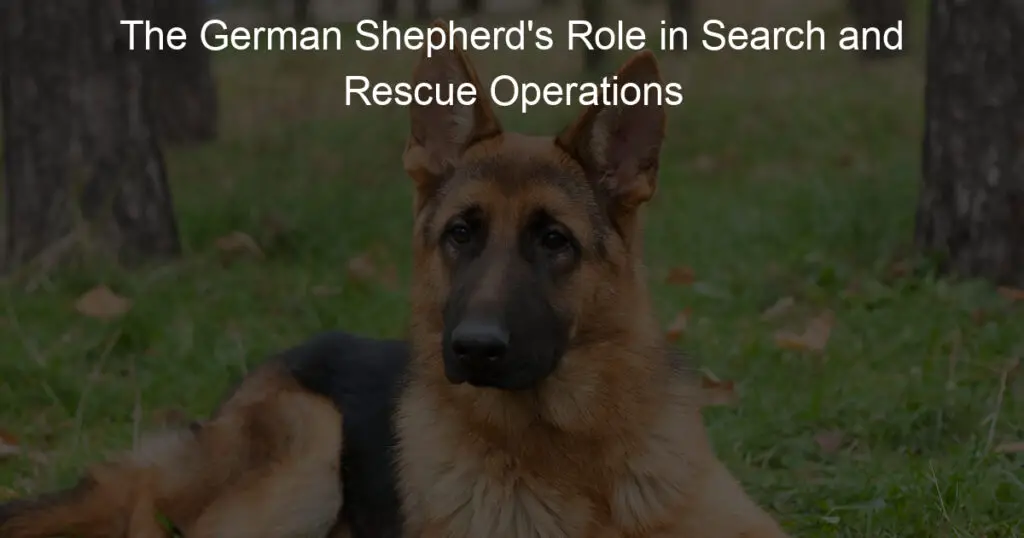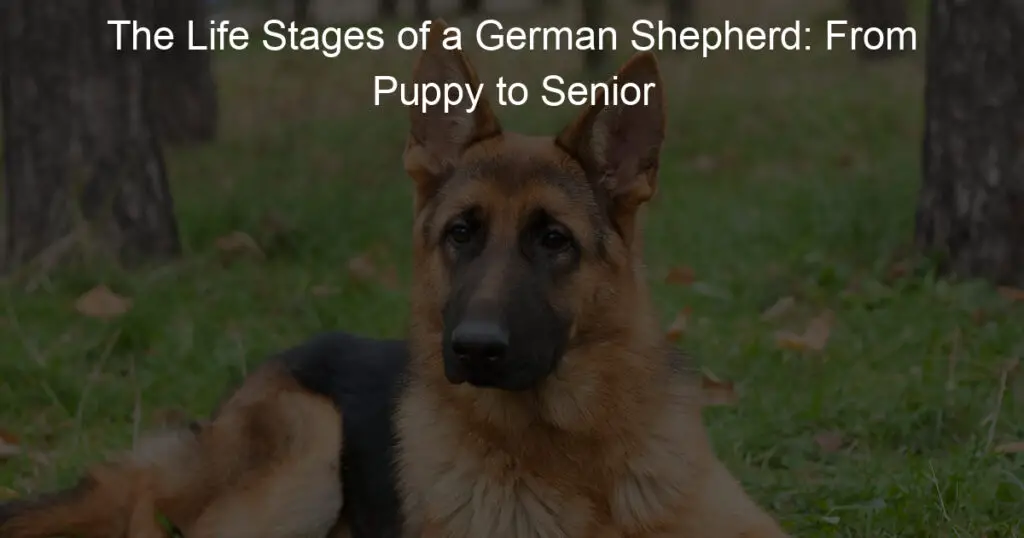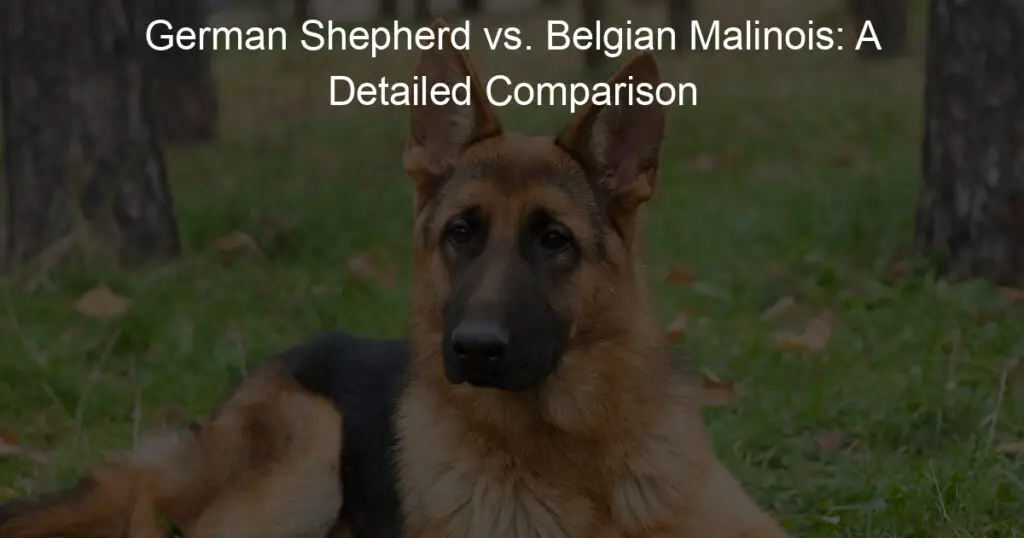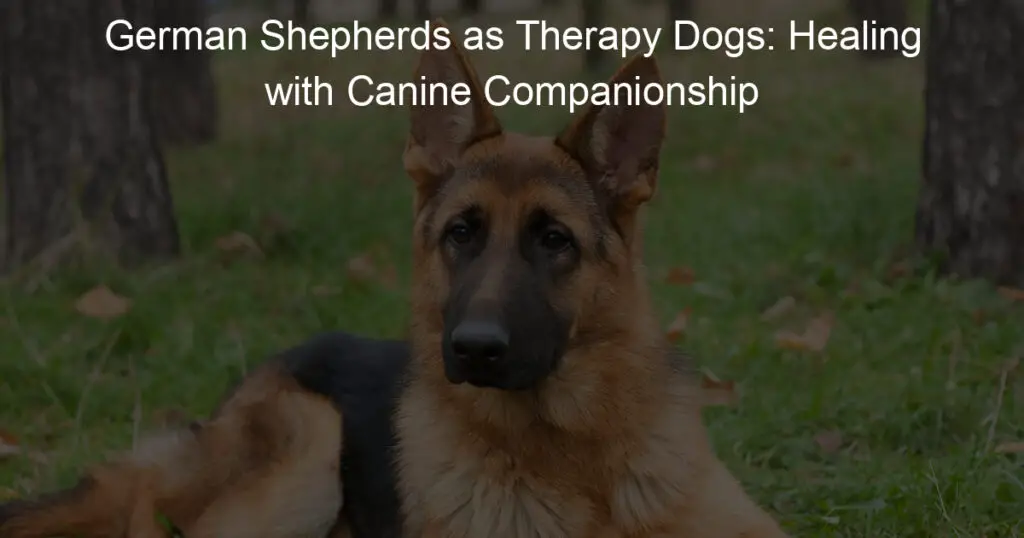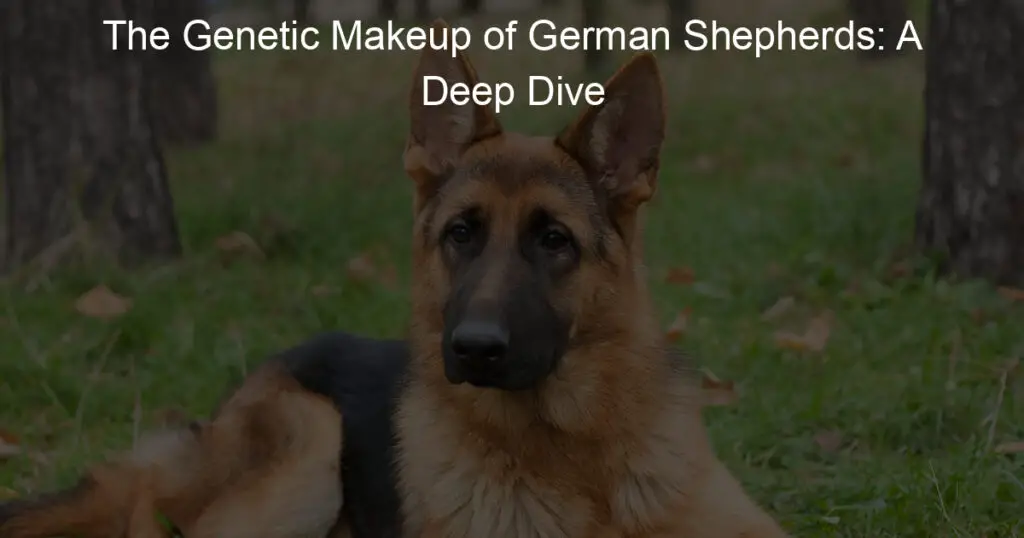When it comes to choosing the perfect canine companion, many people find themselves debating between the German Shepherds vs Belgian Malinois.
Both breeds share similar qualities; they are intelligent, hardworking, and loyal. However, there are also some distinct differences between the two that potential dog owners should consider.
The German Shepherd is a well-known breed, infamous for its police and military work, as well as being a popular family pet.
The Belgian Malinois, though not as well known, is also a strong working breed, gaining attention and admiration for their versatility and athleticism.
By exploring the history, physical characteristics, temperament, and care needs of both breeds, one can better determine which breed is the perfect fit for their lifestyle and needs.
Key Takeaways
- This article compares German Shepherds vs Belgian Malinois to help potential owners make an informed decision.
- Both breeds are intelligent, athletic, and have strong working backgrounds, but they also have notable differences.
- By examining various aspects of each breed, individuals can determine which breed suits their lifestyle and home best.
Origin and History – German Shepherds vs Belgian Malinois
When I think about the history of German Shepherds vs Belgian Malinois, it’s fascinating to see how these breeds have evolved over the years.
Let me share with you some brief insights into their backgrounds.
German Shepherds trace their roots back to Germany in the late 1800s. The breed was initially developed as a herding dog, primarily for sheep.
A man by the name of Max von Stephanitz, a German cavalry officer, saw the potential in these dogs and decided to standardize the breed.
He established the Society for German Shepherd Dogs (Verein für Deutsche Schäferhunde) in 1899 and worked to promote the breed as both a working dog and a loyal companion.
On the other hand, Belgian Malinois originated in Belgium around the same time as the German Shepherds.
They are part of the Belgian Shepherd Dog group, which includes the Groenendael, Tervuren, and Laekenois.
The breed was named after the Belgian city of Malines, where they were primarily developed. Just like German Shepherds, the Malinois was bred to be a herding dog.
It was the steady dedication of Belgian breeders that led to the distinct look and characteristics we know today.
During their respective histories, both breeds have been widely recognized for their intelligence, agility, and hardworking nature. They have played essential roles in various tasks:
- Herding and working on farms
- Police and military work
- Search and rescue operations
- Service and therapy dog capacities
- Obedience and agility competitions
Though hailing from different countries and bearing some differences in appearance and temperament, both German Shepherds and Belgian Malinois share a common purpose and dedication to serving humans.
Their legacy as trustworthy, hardworking companions continues to be cherished by dog lovers worldwide.
Breed Overview
As a dog lover, I’ve always been fascinated by the similarities and differences between various breeds. Today, I’d like to focus on two popular working breeds: German Shepherds and Belgian Malinois.
By understanding their unique characteristics, it’s possible to appreciate their strengths and how these breeds contribute to society.
German Shepherds originated in Germany and were initially bred for herding sheep. Over time, they became popular choices for police, search and rescue, and military purposes due to their intelligence, loyalty, and strong work ethic.
The breed is known for its large size, ranging from 75 to 95 pounds, with males typically larger than females. They sport a medium-length, double coat, which requires regular grooming.
Their friendly, confident, and smart nature made them the perfect choice for families as well.
Belgian Malinois, on the other hand, were bred in Belgium for herding cattle. They share many similar traits with German Shepherds, such as being highly intelligent, loyal, and excellent working dogs.
Nevertheless, Belgian Malinois are slightly smaller, weighing between 60 to 80 pounds, with an athletic build that allows them to be faster and more agile.
Their short, weather-resistant coat needs less maintenance compared to the German Shepherd’s coat.
Because of their high energy levels and strong drive, Belgian Malinoiss are more likely to be employed as police or military dogs rather than family companions.
When it comes to dog sports and training, both German Shepherds and Belgian Malinois are experienced competitors. They excel in obedience, agility, tracking, and protection work.
Their intelligence and eagerness to learn also make them suitable candidates for scent detection, search and rescue, and therapy work.
In terms of popularity, German Shepherds have consistently ranked high in both the United States and worldwide.
Belgian Malinois, although less well-known, have been steadily gaining recognition – primarily due to their outstanding performance as service dogs.
While both breeds are undoubtedly unique and thought-provoking, it’s essential to consider your lifestyle, preferences, and level of dedication before bringing either breed home.
Basic Physical Characteristics
Size and Weight
When observing German Shepherds and Belgian Malinois, I can easily see some differences in their physical characteristics.
German Shepherds are generally larger, with males standing between 24 to 26 inches at the shoulder and females at 22 to 24 inches.
Their weight can range between 75 to 95 pounds for males and 50 to 75 pounds for females.
On the other hand, Belgian Malinois are a bit smaller and lighter. Males typically have a height between 24 to 26 inches, while females stand 22 to 24 inches tall.
Male Malinois usually weigh between 60 to 80 pounds, and females range from 40 to 60 pounds.
Coloring
Both breeds have unique and attractive coat colors. German Shepherds often have a combination of black and tan, with the black saddle marking being a notable feature.
They also come in red and black, sable, and solid black or white variations.
The Belgian Malinois generally have more uniform coloring, with a short-haired coat that ranges from fawn to mahogany, usually accompanied by a black overlay and a black mask.
Lighter colors like silver or cream can occur, but these are not recognized as standard colors.
Appearance
In terms of appearance, both breeds are athletic and well-built. German Shepherds have a slightly sloping back and a bushy tail that curves at the end.
Their ears are large and erect, giving them a distinctive, alert look.
Belgian Malinois have a more lean body structure than German Shepherds and a straight backline. Their tails are also a distinguishing feature, with a tapering shape that reaches the hock.
Like German Shepherds, they have erect ears, adding to their alert and intelligent expression.
Breed Intelligence
As someone who loves dogs, I am always impressed by the intelligence of the German Shepherd and the Belgian Malinois breeds.
Both of these amazing breeds are well-known for their intelligence, which allows them to excel in various roles, from police work to search and rescue.
Since intelligence plays a major role in a dog’s trainability, I thought it would be useful to discuss this aspect of the two breeds.
German Shepherds are often considered one of the most intelligent dog breeds, consistently ranking within the top three.
This level of intelligence, combined with their strong work ethic, makes them highly trainable. They’re known for their ability to learn complex commands quickly and understand what is being asked of them.
This is one of the reasons they are a popular breed for police and military work, search and rescue operations, and assistance dogs.
Belgian Malinois, on the other hand, is also known for being smart and highly intelligent. They can learn new tasks at an impressive rate and are often found in the same working roles as German Shepherds.
One thing to note about Belgian Malinoiss is that their high energy level and intense drive can sometimes make them a bit more challenging to train for first-time or less experienced dog owners.
Both breeds have exceptional problem-solving abilities, which is a key indicator of a dog’s intelligence.
When faced with a challenge, I’ve seen how both German Shepherds and Belgian Malinois will quickly come up with creative solutions to overcome obstacles.
This level of adaptability is, again, one of the reasons they excel in various demanding roles.
To summarize, German Shepherds and Belgian Malinois are both highly intelligent and trainable breeds. They learn quickly, display keen problem-solving abilities, and can manage complex tasks.
Yet, it’s important to remember that their high energy and drive may require extra dedication and patience from their trainer.
As an avid dog lover, I can’t help but admire the brilliance and dedication of both of these wonderful breeds.
Temperament and Personality
In my experience, both German Shepherds and Belgian Malinois are highly active, energetic, and loyal breeds.
As an owner, I have noticed that they’re always on alert and ready to spring into action.
One thing I’ve observed in German Shepherds is their strong drive and determination to excel in tasks.
They can be fiercely independent, which makes them a fantastic option for various roles like police work, search and rescue, and even as service dogs.
In addition, their loyal nature towards their owners can’t be understated.
For Belgian Malinois, one might describe their personality as both driven and energetic. I can attest that they require consistent physical and mental stimulation.
A strong prey drive is typical, making them excellent working dogs, especially in protection and detection jobs.
Regardless, this does mean that they may not always be suitable for households with smaller animals.
In conclusion, both breeds are undoubtedly active and alert by nature, making them strong contenders for various types of work.
They are loyal companions who, when given the proper outlets for their energetic tendencies, can become irreplaceable members of the family.
Exercise and Energy Levels
As someone who’s spent time with both German Shepherds and Belgian Malinois, I can confidently say that exercise and energy levels are vital aspects to consider when choosing the right breed for your lifestyle.
Let me briefly share my observations on these two breeds.
In terms of exercise, both breeds are highly energetic and need lots of physical activity. I’d say Belgian Malinois typically have a higher energy level compared to German Shepherds.
When I take my Belgian Malinois out for a run, she’s always eager to go the extra mile. Running is a great way to keep these high-energy dogs happy and healthy.
They also excel at agility courses and other outdoor activities where they can burn off their excessive energy.
On the other hand, German Shepherds are no slouches when it comes to exercise. Running and playing fetch in the park are some of our favorite bonding activities.
Though their energy levels might be slightly lower than Belgian Malinois, they still require daily exercise and mental stimulation to stay happy and healthy.
A well-exercised German Shepherd is less likely to develop behavioral issues.
When it comes to energy levels, both breeds are considered high-energy dogs, with the Belgian Malinois taking the lead.
I’ve found that my Malinois needs more frequent and intense exercise to stay content. Staying vigilant about providing enough physical activity for these dogs is essential for maintaining a harmonious household.
To sum it up, both German Shepherds and Belgian Malinois are breeds that demand regular exercise and thrive on high-energy activities like running.
If you’re considering welcoming one of these athletic and intelligent breeds into your home, I recommend assessing your lifestyle and your ability to meet their exercise needs.
That way, you’ll ensure a happy and healthy relationship with your canine companion.
Training and Socialization
When it comes to training and socialization, both German Shepherds and Belgian Malinois are highly intelligent breeds.
I find that they respond well to positive reinforcement and consistent routines. However, there are some notable differences in their training needs.
German Shepherds require a lot of patience and consistency during training. They may test their boundaries, so it’s crucial for me to be firm and assertive. Socialization is also essential for German Shepherds, especially when they are young.
They’re naturally cautious around strangers, so exposing them to various environments, people, and other animals early in life will help prevent behaviors such as aggression and shyness.
Belgian Malinois, on the other hand, tend to be more eager to please. I find them easier to train, given their focused nature and drive to work.
Nonetheless, they need a lot of mental stimulation and consistent physical exercise to keep them engaged. Just like German Shepherds, socializing Belgian Malinois during their formative years is vital.
They may also display suspicion or wariness toward strangers, making early exposure to different situations an essential part of their training.
In terms of specific dog training techniques, I found the following to be effective for both breeds:
- Positive reinforcement: Rewarding good behavior with treats, praise, or play keeps them motivated.
- Obedience training: Teaching essential commands like “sit,” “stay,” and “down” helps develop a strong bond with your dog.
- Crate training: Useful for housebreaking and as a safe retreat for your dog during stressful situations.
When training and socializing a German Shepherd or Belgian Malinois, it’s essential to remember that each dog is an individual.
I like to approach training with patience and understanding, adapting to the specific needs of the dog and aiming for a well-balanced, confident, and obedient companion.
Working Roles
As a dog enthusiast, I’m excited to talk about the working roles of German Shepherds and Belgian Malinoiss.
Both of these breeds are well-known for their intelligence and versatility, which makes them excellent working dogs in various fields.
Herding is a natural instinct for both German Shepherds and Belgian Malinois. Historically, they were bred to herd livestock, such as sheep and cattle.
While fewer people rely on these dogs for herding today, their instinctive abilities remain strong, and they continue to excel in herding trials and competitions.
When it comes to police work, both breeds are highly valued by law enforcement agencies. Police dogs are required to perform tasks like tracking, searching, and apprehending suspects.
German Shepherds tend to be more commonly used due to their slightly larger size, strength, and longer history as police dogs.
The Belgian Malinois’ agility and speed make them equally effective in this role. Their skills as herding dogs also translate well into police work, as they can efficiently control and maneuver suspects.
In military operations, both breeds excel in tasks such as detection, protection, and search and rescue missions. They have proven to be invaluable assets for military personnel due to their intelligence, loyalty, and ability to learn complex skills quickly.
While the German Shepherd remains the most popular choice for military working dogs, the Belgian Malinois has gained increased recognition in recent years, particularly thanks to the famous SEAL Team 6 mission that resulted in the elimination of Osama Bin Laden.
As guardians and protectors, both the German Shepherd and Belgian Malinois are highly effective. Their natural instincts to protect their families, combined with their size and strength, make them intimidating and highly capable guard dogs.
They are often trained for personal and property protection, with their loyalty and attentiveness allowing them to excel in these roles.
The German Shepherd and Belgian Malinois are both remarkable working dogs.
While they display some differences in size and physical traits, their intelligent and versatile nature, combined with their strong instincts for herding, police work, military operations, and guarding, make them top choices for various working roles in today’s world.
Lifestyle Suitability
As a German Shepherd owner, I can attest to the fact that both German Shepherds and Belgian Malinoiss are incredible breeds with unique characteristics.
When it comes to lifestyle suitability, these breeds have some similarities and differences to consider.
I’ve observed that both German Shepherds and Belgian Malinoiss are highly intelligent and energetic dogs.
They both require plenty of mental stimulation and physical exercise to keep them happy and healthy. A daily walk or run, along with interactive toys and training sessions, is a must for these active breeds.
In terms of family life, both breeds can be excellent companions for many households. German Shepherds tend to be more protective of their family and are known for their loyalty.
They have a stronger instinct to act as a watchdog, making them vigilant and alert to any potential threats.
This makes them great for families who want a dog that can provide a sense of security.
Belgian Malinois, on the other hand, are friendly and social dogs who enjoy being around people. While they can also be protective, they may be more approachable compared to their German Shepherd counterparts.
This can be a great attribute for households that regularly have visitors or those who want a more sociable pet.
With regards to children, both breeds can be good companions for kids. However, due to their size and strength, it’s essential to supervise their interactions with younger or smaller children.
Proper socialization and training can also further enhance their compatibility with kids and other household pets.
To sum up, your lifestyle and personal preferences can help you decide the most suitable breed between German Shepherds and Belgian Malinois. If you value a strong, protective watchdog, a German Shepherd may be a better fit.
However, if you prioritize a more sociable, friendly companion that still offers protection, a Belgian Malinois could be a great choice. Just remember, both breeds require a commitment to provide them with the physical exercise and mental stimulation they need to thrive.
Health and Lifespan
Common Health Issues
In my experience, both German Shepherds and Belgian Malinois can experience some common health issues.
Let me share those with you:
- Hip dysplasia: This condition is more prevalent in German Shepherds, but Belgian Malinois aren’t immune to it.
- Elbow dysplasia: Both breeds can develop this joint issue, although it might be slightly more common in German Shepherds.
- Bloat: This life-threatening condition can affect both breeds, but good diet management can prevent it.
- Degenerative myelopathy: Primarily seen in German Shepherds, this neurological disorder leads to paralysis and is incurable.
In addition, I’ve observed that both breeds may suffer from eye health issues like progressive retinal atrophy, cataracts, and pannus, which may cause blindness if not treated.
Allergies and cancer are also common concerns in both German Shepherds and Belgian Malinois.
Average Lifespan
Now let’s talk about the lifespan of these two breeds:
| Breed | Average Lifespan |
|---|---|
| German Shepherd | 9-13 years |
| Belgian Malinois | 10-14 years |
As a dog lover, I find these lifespans to be pretty similar, though Belgian Malinois may have a slight edge, usually living a bit longer than German Shepherds.
Proper care and a healthy lifestyle can help these wonderful dogs live up to or even exceed their expected lifespans.
Care Needs
When it comes to grooming, both German Shepherds and Belgian Malinois have similar needs. I find that brushing their coats at least once a week helps to keep shedding under control and prevents matting.
During shedding seasons, I increase the brushing frequency to maintain their healthy coat.
In my experience, German Shepherds might need a bit more attention to their grooming routine due to their thicker double coat, while the Belgian Malinois has a shorter and more manageable coat.
I’ve noticed that both breeds can be prone to separation anxiety if left alone for long periods. They require mental stimulation and regular interaction with their family.
Given their high energy levels, I make sure to provide daily exercise and playtime for both breeds to keep anxiety at bay.
Like many dogs, German Shepherds and Belgian Malinois have some specific needs when it comes to socialization and training.
Since they’re both intelligent and highly trainable breeds, I invest time in their proper training and socialization.
Consistent and positive reinforcement-based training helps them to become well-behaved and confident companions.
The care needs for German Shepherds and Belgian Malinois include regular grooming, providing mental stimulation, and addressing their separation anxiety through exercise and companionship.
By catering to these needs, I can ensure that my furry friends stay happy and healthy throughout their lives.
Comparison: Similarities and Differences
Similarities
Both German Shepherds and Belgian Malinois are highly intelligent and energetic working breeds. They excel in various tasks, such as search and rescue, police work, and obedience training.
These lovely dogs are also loyal companions, making them excellent family pets.
As herding breeds, they share a similar instinct to protect their territory and families. They have an innate drive to work hard and please their humans, which makes them highly trainable.
Their beautiful coats, while different in texture and length, require regular grooming to keep them looking their best.
Differences
Despite their similarities, there are quite a few differences between German Shepherds and Belgian Malinois.
Firstly, their appearance differs significantly. German Shepherds are larger, with a more robust build, while Belgian Malinois are leaner and more agile.
When it comes to temperament, German Shepherds tend to be more reserved with strangers and protective of their family, whereas Belgian Malinois are friendlier and more outgoing.
This difference in temperament can make Belgian Malinois a better choice for families with young children.
Furthermore, the energy levels of these breeds are different. Belgian Malinois have a higher energy level and require more daily exercise and mental stimulation than German Shepherds.
This means that a Belgian Malinois may not be the best fit for a home with limited space or less active families.
While both German Shepherds and Belgian Malinois make excellent working dogs and loving family companions, it’s essential to consider the differences and choose the breed that best suits your lifestyle and preferences.
Breed Specific Information
When it comes to German Shepherds (GSD) and Belgian Malinois (Malines), there are some breed-specific differences that I’d like to share with you as a friendly guide.
Firstly, let me talk about GSDs. They are known for their versatility and intelligence. These dogs are excellent at tracking, making them ideal for search and rescue missions or police work.
They are also characterized by their thick double coat, which helps them withstand cold temperatures. GSDs have a calm and steady disposition but can be protective of their families when needed.
On the other hand, Belgian Malinois are also quite intelligent and have high-energy levels, which make them amazing at various tasks such as detecting explosives and narcotics, and even locating fire origins.
Malines are known for their speedy nature and athleticism, which is perfect for working roles that require agility.
One noticeable physical difference between the two breeds can be seen in their ears. Belgian Malinois have shorter and more triangular ears compared to the German Shepherds.
One potential behavioral difference is that Malines are sometimes known to be more stubborn in comparison to GSDs.
As with any breed, there can be aggressive individuals, but it’s essential to remember that training, socialization, and proper care greatly impact a dog’s temperament.
Both GSDs and Malines can be excellent companions with the right amount of dedication and understanding.
Here’s a brief comparison chart to help you visualize the differences and similarities between these two breeds:
| Aspect | German Shepherd | Belgian Malinois |
|---|---|---|
| Tracking | Excellent | Good |
| Speed | Good | Excellent |
| Coat | Thick Double Coat | Shorter Single Coat |
| Ears | Medium, More Pointed | Short, Triangular |
| General Temper | Calm and Steady | High Energy and Agile |
| Stubbornness | Less | More |
I hope this information is helpful in understanding the breed-specific characteristics of these two amazing dog breeds!
Breeding Information
When it comes to breeding German Shepherds and Belgian Malinois, I’ve found that there are some similarities and differences between the two breeds.
In this section, I’ll share some key breeding information for both breeds.
First, both German Shepherds and Belgian Malinois have a typical litter size of about six to eight puppies.
Nevertheless, the size of the litter can sometimes vary depending on the individual dog, with some litter being larger or smaller.
For the health of both the mother and the puppies, it’s important to ensure that the parents are in good health and have been screened for any potential genetic issues.
German Shepherds, for example, should be screened for hip dysplasia, a common genetic issue in the breed.
Belgian Malinois, on the other hand, should be tested for hip and elbow dysplasia, as well as eye issues and certain heart conditions.
It’s also important to choose the right time to breed your dog. Both breeds reach sexual maturity around the age of six to nine months, but it’s generally better to wait until they are fully grown and emotionally mature before breeding.
For German Shepherds, this typically means waiting until they are at least two years old, while Belgian Malinois may be ready to breed by the time they are 18 months old.
When selecting a mating partner, it’s essential to consider the temperament and physical characteristics of both dogs. Ideally, you want to choose a mate that will complement and improve upon your dog’s qualities.
Breeding practices for both German Shepherds and Belgian Malinois include:
- Ensuring that both parents have been health tested for common breed-specific issues
- Breeding dogs that are emotionally and physically mature
- Carefully selecting a mate with complementary traits
- Providing prenatal and postnatal care for the mother and puppies
In conclusion, while there are some differences in breeding practices for German Shepherds and Belgian Malinois, there are also many similarities.
By following the information I’ve shared, you can help ensure both breeds can continue to flourish.
Frequently Asked Questions
What are the main differences in personality between German Shepherds and Belgian Malinois?
In my experience, German Shepherds tend to be more protective and loyal, staying close to their owners and guarding their homes.
They can be a little more reserved with strangers. Belgian Malinois, on the other hand, tend to be more energetic and enthusiastic, always ready to play or engage in activities.
They can be friendlier with new people but still remain loyal to their owners.
How do the energy levels of German Shepherds and Belgian Malinois compare?
Both breeds are known for their high energy levels, but I’ve noticed that Belgian Malinois are typically more energetic than German Shepherds.
They require lots of physical activities and mental stimulation to keep them happy and well-behaved.
German Shepherds also enjoy daily exercise and mental challenges, but they may be slightly calmer when indoors or resting.
Which breed is better suited for working in military or police forces?
In general, both breeds have been used extensively in military and police work due to their intelligence, obedience, and working drive.
While it’s difficult to say which breed is better suited for these roles, Belgian Malinois have recently gained recognition for their agility, strength, and ability to learn quickly, which makes them a popular choice for certain law enforcement and military tasks.
What is the difference in training requirements for German Shepherds and Belgian Malinois?
Both breeds require consistent training and positive reinforcement to bring out the best in their personalities and abilities. German Shepherds are known for their intelligence and ability to learn quickly but may require more patience during the training process.
Belgian Malinois are also highly intelligent, and they tend to excel in activities that challenge them both physically and mentally.
Due to their high energy levels, they may need additional training sessions to keep them engaged and focused.
Can you compare the bite force between German Shepherds and Belgian Malinois?
While both breeds have strong jaws and a powerful bite, the bite force of a German Shepherd is typically stronger than that of a Belgian Malinois.
Yet, the actual bite force can vary depending on factors like age, size, and individual genetic traits. It’s important to remember that a dog’s bite force should not be the primary factor in determining which breed is best for you, as proper training can ensure a well-behaved and controlled dog.
Why might someone choose a Belgian Malinois over a German Shepherd, or vice versa?
The decision to choose one breed over the other really depends on personal preferences and lifestyle. If you’re looking for a highly energetic and agile dog who thrives on physical activity, a Belgian Malinois might be the right choice for you.
On the other hand, if you prefer a protective, slightly calmer, and loyal companion, a German Shepherd could be a better fit.
Regardless, I always recommend spending time with both breeds before making a decision, as each dog’s personality can vary greatly.










